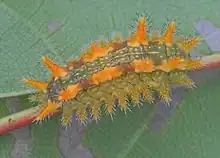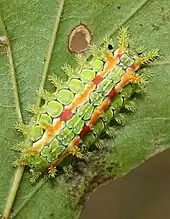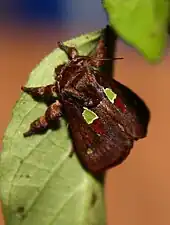Spiny oak slug
The spiny oak slug (Euclea delphinii) is the larval form (caterpillar) of a moth in the family Limacodidae.
| Euclea delphinii | |
|---|---|
 | |
| Scientific classification | |
| Domain: | Eukaryota |
| Kingdom: | Animalia |
| Phylum: | Arthropoda |
| Class: | Insecta |
| Order: | Lepidoptera |
| Family: | Limacodidae |
| Genus: | Euclea |
| Species: | E. delphinii |
| Binomial name | |
| Euclea delphinii (Gray, 1832) | |
Life cycle
There is one generation a year in the most of the northern parts of its range, with caterpillars seen from late June to October (Wagner 2005). Two generations or more from Missouri south.
Egg
Eggs are laid singly or in small clusters on leaves (Wagner 2005).
Larva

.jpg.webp)
The larva is flattened and ovoid in outline, with spiny tubercules along the back and sides. These are venomous, producing symptoms in humans that vary from mild itching and burning to more serious reactions that require medical attention (Florida Poison Information Center 2015). The sides have craters ringed with black or white along them. In the final instar they usually have two to four sets of black hairs at the tail end, that can fall off, called 'caltrop' spines after the Roman defensive weapons. Colourful, but the colours vary enormously (Wagner 2005). Like all limacodids, the legs are shortened and the prolegs are reduced to suction cups. Maximum length, 20 mm (Wagner 2005).
Pupa
Pupates in a cup-shaped cocoon with a circular escape hatch.
Adult

The small (1 cm) moth is 'hairy' and brown, with green patches on the upper wing. The underwing is a paler grey-brown.
Parasitoids
A number of parasitoids have been recorded on spiny oak slug caterpillars, including tachinid flies (Uramya pristis; Austrophorocera einaris; Compsilura concinnata), eulophid wasps (Platyplectrus americana; Pediobius crassicornis), and braconid wasps (Cotesia empretiae; Triraphis discoideus). An egg parasitoid of genus Trichogramma was also recorded.(Gates et al 2012)
Food plants
Eats a variety of deciduous trees and shrubs, not limited to: apple, ash, basswood, beech, birch, blueberry, cherry, chestnut, hackberry, hickory, maple, oak, poplar, sycamore and willow (Wagner 2005).
References
- "Stinging Caterpillars". Florida Poison Information Center – Tampa. 2015. Retrieved 2018-08-25.
- Wagner, DL (2005). Caterpillars of Eastern North America. Princeton University Press.
- Gates, Michael W.; Lill, John T.; Kula, Robert R.; O'Hara, James E.; Wahl, David B.; Smith, David R.; Whitfield, James B.; Murphy, Shannon M.; Stoepler, Teresa M. (January 2012). "Review of Parasitoid Wasps and Flies (Hymenoptera, Diptera) Associated with Limacodidae (Lepidoptera) in North America, with a Key to Genera". Proceedings of the Entomological Society of Washington. 114 (1). doi:10.4289/0013-8797.114.1.24.